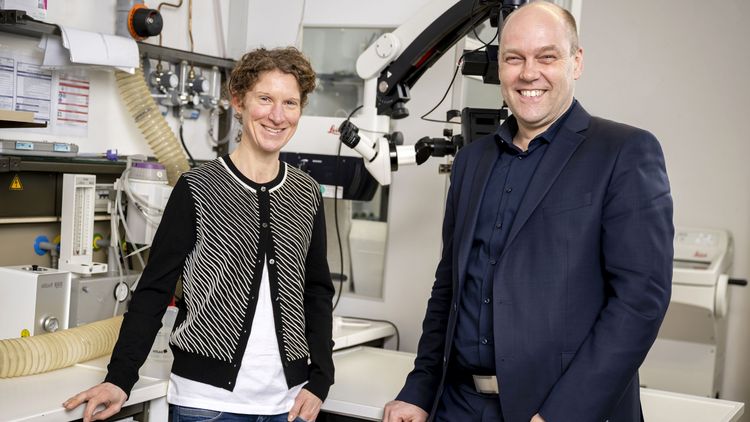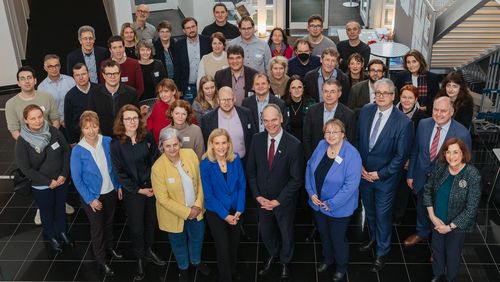Animal navigation and orientation is a research focus area at the University of Oldenburg. In this interview, biologists Henrik Mouritsen and Miriam Liedvogel explain the importance of this topic for nature conservation – as well as for quantum technologies and autonomous vehicles.
Billions of animals migrate every year, sometimes travelling extremely long distances. Which navigational feats in the animal kingdom do you find the most exciting?
Liedvogel: That young birds on their first migratory flight find their way to places they have never visited before is truly amazing. These birds hatch from their eggs here in Europe and then fly to Africa. The parents make the journey around two weeks earlier on average. You would think that such young birds would have no clue where Africa is. But they know which direction to fly, when to leave and when they have reached their destination.
Mouritsen: It's incredible that they can reach their destination despite having virtually no points of reference.
Liedvogel: And when they return to their wintering grounds a year later, they seek out exactly the same branch to sleep on after flying thousands of kilometres – which is also very impressive.
How important is the phenomenon of animal migration for ecosystems worldwide?
Mouritsen: I’ll give just one example to illustrate the dimensions we’re talking about here: each year around two billion birds migrate between Africa and Europe. These are gigantic shifts in biomass, which of course have an enormous global impact.
Liedvogel: But insects also play an important role in ecosystems. Much of the agricultural industry would cease to function without insects as pollinators, and a large proportion of these insects also migrate, as we have only recently learned. Billions of hoverflies fly across the English Channel every year. Butterflies like the admiral cross the Alps. It is crucial for our food supply that all these creatures are in the right place at the right time.
Understanding how animals deal with space and time and how they move around is becoming even more important in the context of climate change.
What challenges does climate change pose for migratory species?
Mouritsen: Warmer temperatures cause habitats to shift. This means that animals have to move around more simply because they have to follow their habitats. So understanding how animals deal with space and time and how they move around is becoming even more important in the context of climate change.
Liedvogel: A problem that affects migratory species in particular is that the changes along the migration route are not interlinked. Those that migrate long distances are the least flexible. If they don’t leave their breeding grounds at the right time in autumn, they may not be able to find food en route and thus may not survive the journey.
Mouritsen: In fact, it’s the bird populations that migrate to Africa that are experiencing the most dramatic decline. And for them, the problem is not just climate change, but also the ongoing desertification in the Sahel region south of the Sahara, which is also linked to the rapid growth of human populations there. These birds already have to almost double their bodyweight just to have enough energy to fly across the Sahara and the Mediterranean. Their internal organs are partially consumed during the flight. If the desert continues to expand, they will probably no longer be physiologically capable of crossing this enormous barrier.
How can we help migratory species to adapt to the changes?
Mouritsen: This is a topic that we would like to explore in the near future. But first of all, we need to gain a very precise understanding of how animals navigate to a particular location and what cues they use to do this. This will allow us to draw conclusions about the disruptions they face and how they could be encouraged to relocate to a different area or change their migration route, for example.
Can this knowledge be put into practice?
Liedvogel: There are already numerous rewilding projects in which conservationists are trying to halt or even reverse local extinctions. These involve reintroducing parts of a healthy population or animals reared in captivity to a suitable location in the wild. But according to the 2023 UN Biodiversity Conference in Montreal, less than half of these rewilding projects actually succeed. In many cases this is because the animals don’t stay in the place where they are released. They sense that this is not ‘home’. So we need to understand how animals define ‘home’ and we need to understand their navigation mechanisms and sensory perception. One idea for solving the problem is to keep young birds isolated from certain information about their location until they have been brought to the place where they are to be released, so that they accept it as their home. But at this stage we still know too little.
A critical factor in the navigation of migratory birds is their magnetic sense, which is being researched in detail here in Oldenburg together with researchers from Oxford, also in your own Collaborative Research Centre “Magnetoreception and Navigation in Vertebrates”. How does this sensory perception work?
Mouritsen: We know that the magnetic sense is light-dependent. We know that birds measure the angle of inclination of the magnetic field lines with respect to the Earth's surface, the so-called magnetic inclination. We know that the magnetic compass is located in the eye and that the information is processed in the part of the brain that deals with visual information. And we have a hypothesis about the mechanism behind this: there is a protein in their eyes, cryptochrome 4, which detects magnetic fields via a quantum mechanism. We can now produce and analyse this protein molecule using bacterial cultures. Together with our partners in Oxford we have been able to show that the cryptochrome 4 of robins is magnetically sensitive. Although this is not yet proof, it is a clear indication.
Science has long assumed that the energy generated by the Earth’s magnetic field was nowhere near strong enough to influence biomolecules.
Mouritsen: Yes, it was said, for example, that the Earth’s magnetic field was too weak to split bonds within proteins by a factor of 10 million. In the meantime, we have proven beyond doubt that fields that are about a hundred times as strong as the Earth’s magnetic field – in other words, a hundred thousand times weaker than the originally assumed limit – most certainly do have an effect on the magnetically sensitive protein we are investigating. And we believe that this magnetic sensitivity increases in the molecule’s natural environment – in this case, a sensory cell in the eye. To simulate this effect, we produced artificially mutated proteins, which we are currently testing.
Liedvogel: Interestingly, my colleague Corinna Langebrake and I observed in a separate genetic study that the exact same areas of the protein which you are now investigating have changed over the course of bird evolution – the efficiency of the protein for magnetic perception has probably continued to improve over millions of years.
A few years ago, it was also considered unlikely that quantum-mechanical effects could play a role in biology.
Mouritsen: Yes, because quantum phenomena are usually only visible at very low temperatures or on extremely tiny length scales. The conventional wisdom was therefore that quantum effects were far too fragile to play a significant role in the warm, humid and chaotic environment of a cell. But this is clearly not true, and in my view this is the most exciting aspect. It means that this research has a fundamental importance that goes far beyond birds. If someone had told me 20 years ago that people who build quantum computers might be interested in how migratory birds find their way to Africa, I would have thought they were crazy!
If the principle could be transferred from biology, it could lead to solutions for quantum computers or quantum sensors that would be much easier to use than today’s technologies.
So what does magnetoreception in birds have to do with quantum computers?
Mouritsen: Mechanisms very similar to those we hypothesise that birds use for magnetoreception could be used to store information in quantum computers. More specifically, this involves what is known as coupled electron spins. Spin is a quantum-mechanical property of electrons. In magnetoreception, two electrons are presumably coupled with each other for fractions of a second through their spin. You could picture them as mini magnets, and depending on the direction of the two spins, they are influenced by magnetic fields such as the Earth's in different ways. In a quantum computer, electron spins could form the basis for qubits – the basic unit of information in quantum computing. However, most current quantum computer architectures work at temperatures just above absolute zero. Birds, on the other hand, seem to use this mechanism at temperatures of plus 40 degrees Celsius! If the principle could be transferred from biology, it could lead to solutions for quantum computers or quantum sensors that would be much easier to use than today’s technologies. Not tomorrow, and not the day after, but perhaps ten or twenty years from now. Our future research will therefore be aimed at gaining a better understanding of quantum-mechanical effects at room temperature.
Could animal navigation systems serve as a model for new technologies in other ways?
Liedvogel: We want to explore that possibility too. We believe autonomous technical systems could be improved if, like animals, they were to rely on a large number of simple sensors for navigation, rather than just a few highly precise but very complicated sensors.
Mouritsen: Navigating animals are very smart in how they use resources: they have millions or even billions of relatively imprecise sensors – such as cryptochrome proteins – to determine the direction of the magnetic field. Yet taken together, the average value determined by all these sensors is highly accurate. In addition, although these animals have a relatively small ‘computer’, the high quality of the information that their brains receive from their sensory organs means they can draw on relatively simple decision-making algorithms. So when it comes to difficult decision-making and energy efficiency, they are superior to technical systems. If you combine the solutions from biology with technical, AI-based solutions, you get the best of both worlds.
Interview: Ute Kehse and Volker Sandmann





